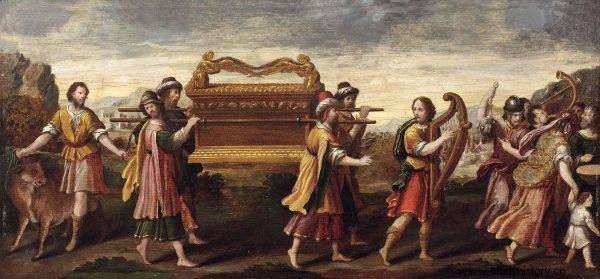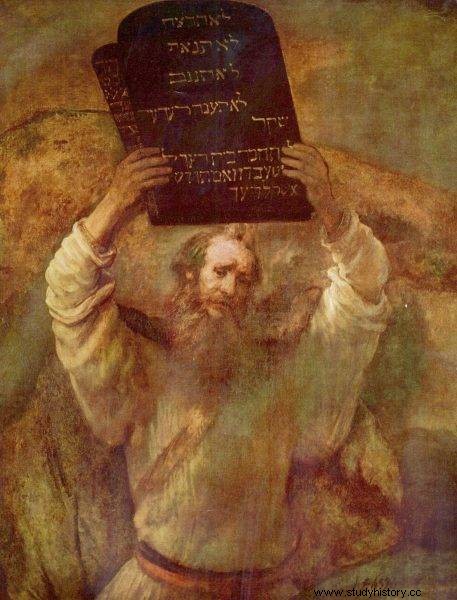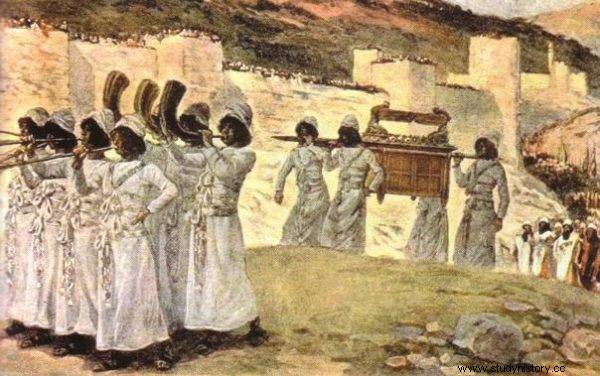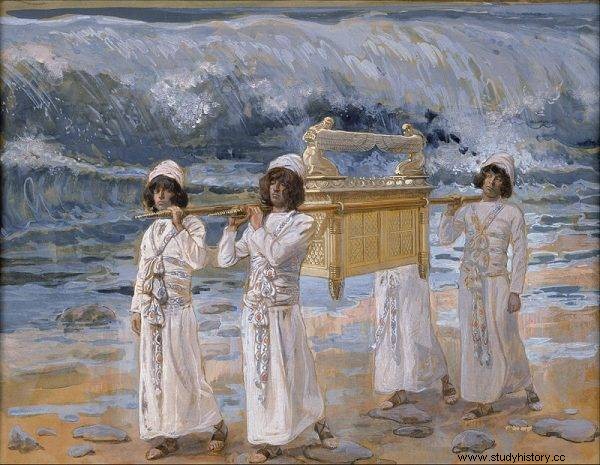A ritual item, lethal weapon or work of an alien civilization. What was the Ark of the Covenant? Where is she missing? Has she been hidden? Or maybe it didn't exist at all?
This is a ready-made script for a movie straight from Hollywood. It is about the history of the Ark of the Covenant, a mysterious artifact that was to give the Israelites going to the Holy Land great power.
The dimensions and type of materials as well as the method of making the Ark were dictated by Yahweh himself to the chosen people. It is said that Moses placed in it stone tablets of the Decalogue, which he received from God. What was the Ark of the Covenant? A ritual object, a lethal weapon, or maybe the work of an alien civilization? Where is she missing? Has she been hidden? Did it even exist? These are only part of the long list of questions related to this enigmatic subject.
No wonder that this case provokes a search for both professional scientists and home-grown researchers. All sorts of ideas are formulated about the destiny of the Ark of the Covenant and its fate - from scientific to utterly fantastic, which attribute it to an extraterrestrial origin.
On behalf of Jehovah
Everything we know about the Ark comes from the Bible. The Book of Exodus describes the fate of the chosen people after they left the Egyptian slavery under the leadership of the patriarch Moses and his brother Aaron. During the long and exhausting march to the Promised Land, Moses left his people to talk to God on Mount Sinai. It was then Yahweh gave Moses the Ten Commandments on two tablets of stone . The handing over of the tablets was related to the new covenant that God made with the people of Israel:
You saw what I did to Egypt, how I carried you on eagles' wings and brought you to me. Now, if you will listen to my voice and keep my covenant, you will be my special possession among all nations, for all the earth belongs to me.

Everything we know about the Ark comes from the Bible.
The Sinai covenant took place in very spectacular circumstances. Yahweh commanded Moses to prepare for the festivities, to wash their clothes. Men were to stay away from women for three days. God said he would come up the mountain and only let him get to the top. He ordered Moses not to come up the hill and touch it. Otherwise, he faced death.
On the morning of the third day there was thunder and lightning, and a thick cloud spread over the mountain and a mighty trumpet sounded, so that all the people in the camp trembled with fear. Moses led the people out of the camp to meet God and set them up at the foot of the mountain. And Mount Sinai was all shrouded in smoke, for the Lord had descended on it in fire (...).
Detailed guidelines
God dictated to Moses not only the Ten Commandments, but also a whole set of laws that governed all aspects of Israel's life - including livestock bills, usury issues, and a number of other specific regulations. Another command from Yahweh to the Israelites was to build a portable temple (the Holy Tabernacle) and the Ark of the Covenant that was to be in it.
And they will make an ark of acacia wood; its length will be two and a half cubits; it is a cubit and a half high and it is a cubit and a half wide. And you will cover it with pure gold inside and out and make golden wreaths around it . You will cast four rings of gold for it and attach them to its four edges:two rings on one side of it and two on the other side.
You will order the poles to be made of acacia wood and overlay them with gold. And you shall put the poles into the rings on the sides of the ark to carry it. The poles will remain in the ark's rings and will not be removed from them (...).
And you shall make a mercy seat of pure gold:it shall be two and a half cubits long, and a cubit and a half wide; and you shall make two cherubim of gold. And you will make them at both ends of the mercy seat. (...) You will put the mercy seat on top of the ark and put the testimony in the ark, which I will give you.

Yahweh gave Moses a very specific "project."
The detail of the description amazes historians and biblical scholars. Yahweh gave Moses a very specific “design.” The Ark of the Covenant was 140 cm long by 80 cm wide and 80 cm high. The very material it was made of made it an extremely valuable item. Inside and outside, it was upholstered with gold and had a golden, ornamented cover.
What was that Testimony mentioned in the Bible that was inside the Ark? It is believed that these are the tablets with the commandments. This would indicate that the Ark is an occasional religious artifact, which is an expression of gratitude and, at the same time, evidence of a covenant with God. However, this is a far insufficient characteristic. The biblical accounts show that it played a much more important role.
Weapons of mass destruction
The Israelites on their way to the Promised Land used the Ark of the Covenant as ... a weapon. The Israelite army carried it with them to all military campaigns. A special wagon was used for this, on which there was a mysterious chest, hidden from the prying eyes.
During the siege of Jericho, the Ark was carried along the mighty walls for a week amid the sound of trumpets from rams' horns (shofars). The "instructions" for conquering the city around 1220 BC were dictated to Joshua by Yahweh himself. At the end of the seventh day, after seven laps performed by seven priests out of the 40,000 throats of the Israeli warriors, a loud battle cry was heard . Then the walls of Jericho collapsed like a house of cards. The Israelites stormed in and slaughtered the inhabitants.

The ark in front of the walls of Jericho
The description shows that the Ark had a mysterious power. However, it did not serve everyone. The Philistines, bitter enemies of the Israelites, at one point managed to take it over, but eventually gave the artifact back to its rightful owners, convinced that it was working to their detriment.
Telecommunications terminal
The mysterious chest was not only a weapon. It was through her that Yahweh contacted Moses. So it was also used for communication. At the time of its journey to Kaanan, it was in the Holy Tabernacle, a portable temple, the "design" of which was again dictated by Yahweh Moses with great precision.
The tabernacle was made down to the last detail as "ordered". God specified not only its dimensions, but also the type of materials from which it was to be made, the number of fabric layers, the type of hooks used to hang them, the dimensions of the courtyard and individual parts temple and many other details.
The most important part of the Tabernacle - the so-called The Most Holy Place - it was occupied by the Ark. Inside it, in addition to the tablets with the commandments, there was also to be a bucket of manna, i.e. a special food that the Lord gave the Israelites during their wandering through the desert and the rod of Aaron - which, by the power of Yahweh, blossomed to silence the murmurs of the rebellious Israelites.
Directly above the Ark, between two golden cherubs, there was, according to the Bible, a supernatural light, the only one in the room. That light - which is the immediate presence of Yahweh - is Shekhinah. Through them, Yahweh contacted Moses and the priests.
Not for everyone
Only the consecrated high priests, including Aaron, had the right to enter the Most Holy. Each entry and exit from the Tabernacle was associated with a series of activities that were to ensure that the priest would survive. Otherwise, he could be in danger of death:
The golden bell and the pomegranate will alternate around on the lower sides of the dress. And it will be worn by Aaron while in service, so that the sound will be heard when he enters the Holy Place before the Lord and when he leaves - lest he die (…).

Where did the Ark of the Covenant go? There are several potential locations.
Also for the sons of Aaron you will make a tunic and make them belts and mittens in honor and decoration . You will clothe your brother Aaron and his sons with them, anoint them, make them priests, and consecrate them to serve me as priests. (…) Make them linen pants so that they cover the nakedness of the body from the hips to the shins. And they will be worn by Aaron and his sons whenever they enter the Tent of Meeting or approach the altar for service in the Holy Place, lest they bear sin and die.
Raiders of the Lost Ark
Where did the Ark of the Covenant go? There are several potential locations. It is known that during the pilgrimage to the Holy Land, it was kept for some time in the Mosaic Tabernacle, which was to be located in the ancient city of Shiloh (16 km north of Beth El in the West Bank).
In the days of the kings of David and Solomon, it was to be in Jerusalem. She was lost when in the 6th century B.C.E. Babylonian armies invaded the nation of Israel, demolishing the first temple. For the second time - more than half a millennium later - it was destroyed by the Romans. They didn't find the Ark. It was probably deported 500 years earlier, before the conquest of the city by the troops of Nebuchadnezzar II.
Where was she taken? It is not known. The magic of the Ark over the centuries influenced the imagination of the next generations so strongly that not only scientists were looking for it. During World War II, it became - along with other biblical artifacts - of interest to the Nazis.
Today, various - more or less sensible - theories about the further fate of the Ark are often formulated by supporters of secret knowledge, conspiracy theories, as well as UFO researchers and supporters of the so-called paleoastronautics. According to them, the Ark of the Covenant was a technologically advanced device that aliens, claiming to be a deity, handed over to the Israelites , and which served, inter alia, to produce manna and had a mysterious, overwhelming, lethal power - possibly radioactive.
Well, one thing is for sure. We will hear more than once about this mysterious artifact from millennia, which was lost in the darkness of history.
Bibliography:
- The Millennium Bible, Pallottinum Publishing House, 1965.
- Erich von Däniken, Ancient Cosmonauts , Świat Książki Publishing House 1995.
- Janusz Lemański, The Ark of the Covenant in the history of the chosen people:between history and theology, Szczecin, WT US, 2006.
- Roderick Gierson, Stuart Muntro-Hay, The Ark of the Covenant , Warsaw, Amber, 20 00.
